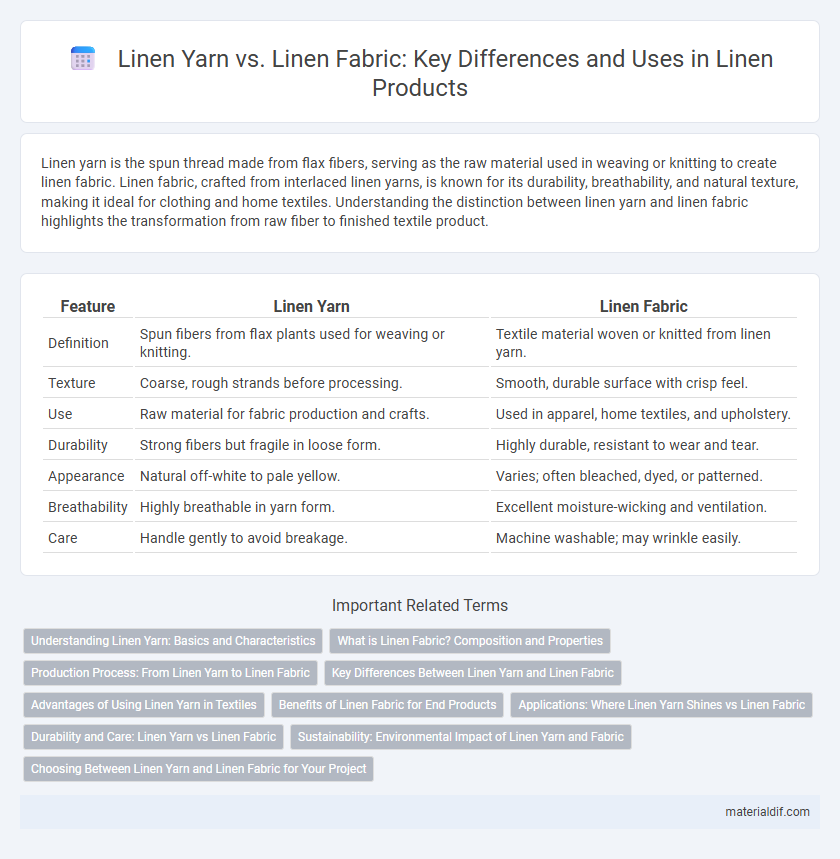Linen yarn is the spun thread made from flax fibers, serving as the raw material used in weaving or knitting to create linen fabric. Linen fabric, crafted from interlaced linen yarns, is known for its durability, breathability, and natural texture, making it ideal for clothing and home textiles. Understanding the distinction between linen yarn and linen fabric highlights the transformation from raw fiber to finished textile product.
Table of Comparison
| Feature | Linen Yarn | Linen Fabric |
|---|---|---|
| Definition | Spun fibers from flax plants used for weaving or knitting. | Textile material woven or knitted from linen yarn. |
| Texture | Coarse, rough strands before processing. | Smooth, durable surface with crisp feel. |
| Use | Raw material for fabric production and crafts. | Used in apparel, home textiles, and upholstery. |
| Durability | Strong fibers but fragile in loose form. | Highly durable, resistant to wear and tear. |
| Appearance | Natural off-white to pale yellow. | Varies; often bleached, dyed, or patterned. |
| Breathability | Highly breathable in yarn form. | Excellent moisture-wicking and ventilation. |
| Care | Handle gently to avoid breakage. | Machine washable; may wrinkle easily. |
Understanding Linen Yarn: Basics and Characteristics
Linen yarn is made from the fibers of the flax plant, characterized by its natural strength, durability, and smooth texture, making it ideal for weaving high-quality linen fabric. Unlike linen fabric, which is the final woven or knitted textile product, linen yarn serves as the raw material, influencing the texture, weight, and breathability of the finished fabric. Understanding the spinning process and fiber length in linen yarn production is essential to achieving the distinct crispness and moisture-wicking properties associated with premium linen fabric.
What is Linen Fabric? Composition and Properties
Linen fabric is a textile made from the spun fibers of the flax plant, renowned for its strength, durability, and natural luster. Its composition consists primarily of cellulose fibers, which contribute to excellent moisture-wicking abilities, breathability, and resistance to heat, making it ideal for warm climates. Linen fabric's properties include high tensile strength, a crisp texture, and the tendency to soften with each wash while maintaining its resilience and eco-friendly characteristics.
Production Process: From Linen Yarn to Linen Fabric
Linen yarn is produced by spinning flax fibers extracted from the flax plant, a process involving retting, breaking, scutching, and hackling to obtain smooth, long fibers ideal for yarn formation. The yarn is then woven or knitted into linen fabric, where the yarn's quality directly influences the fabric's strength, texture, and breathability. Understanding this transformation from flax fibers to yarn and finally fabric highlights the meticulous craftsmanship and natural qualities that define linen textiles.
Key Differences Between Linen Yarn and Linen Fabric
Linen yarn consists of individual threads spun from flax fibers, offering strength and breathability ideal for weaving or knitting. Linen fabric results from weaving or knitting linen yarns into a textile with varying textures and weights used in clothing, upholstery, and home textiles. Key differences include linen yarn's role as the raw threading material, while linen fabric is the finished product characterized by durability, moisture-wicking properties, and a distinctive natural luster.
Advantages of Using Linen Yarn in Textiles
Linen yarn offers superior strength and durability compared to other natural fibers, enhancing the longevity of textiles. Its natural moisture-wicking properties provide breathability and comfort, making it ideal for warm climates. The fine texture and smoothness of linen yarn result in high-quality fabrics with excellent drape and aesthetic appeal.
Benefits of Linen Fabric for End Products
Linen fabric offers superior breathability and durability compared to linen yarn, making it ideal for end products that require longevity and comfort. Its natural moisture-wicking properties help regulate body temperature, enhancing wearer comfort in garments and home textiles. High tensile strength and resistance to wear ensure linen fabric maintains shape and texture through repeated use and washing.
Applications: Where Linen Yarn Shines vs Linen Fabric
Linen yarn excels in textile crafts such as knitting and weaving, allowing for customized patterns and intricate designs ideal for handbags, home decor, and lightweight apparel. Linen fabric, crafted from woven linen yarns, is predominantly used in ready-made clothing, upholstery, and drapery due to its durability, breathability, and elegant texture. While linen yarn offers creative flexibility for artisans, linen fabric provides practical applications in fashion and interior design with its consistent structure and comfort.
Durability and Care: Linen Yarn vs Linen Fabric
Linen yarn, made from flax fibers, offers exceptional strength and flexibility that contributes to the overall durability of linen fabric. Linen fabric, woven from these yarns, inherits the durability but requires specific care such as gentle washing and avoiding high heat to maintain its integrity and prevent fiber damage. Proper care prolongs the lifespan of linen fabric, ensuring the natural strength of linen yarn translates into long-lasting, resilient textiles.
Sustainability: Environmental Impact of Linen Yarn and Fabric
Linen yarn production involves minimal water usage and relies on flax cultivation, which enriches soil health and reduces pesticide dependence, making it highly sustainable. Linen fabric retains these eco-friendly properties through biodegradable fibers and durability, allowing for longer garment life and reduced waste. The closed-loop process from yarn to fabric ensures lower carbon emissions compared to synthetic textiles, emphasizing linen's role in sustainable fashion.
Choosing Between Linen Yarn and Linen Fabric for Your Project
Choosing between linen yarn and linen fabric depends on the project's requirements for texture, durability, and flexibility. Linen yarn offers versatility for hand knitting or weaving, allowing customized thickness and pattern design, while linen fabric provides ready-to-use material with consistent texture and strength ideal for upholstery or garment construction. Evaluate project scale and crafting skills to determine whether the raw yarn or finished fabric best suits your desired aesthetic and functional outcome.
Linen Yarn vs Linen Fabric Infographic

 materialdif.com
materialdif.com